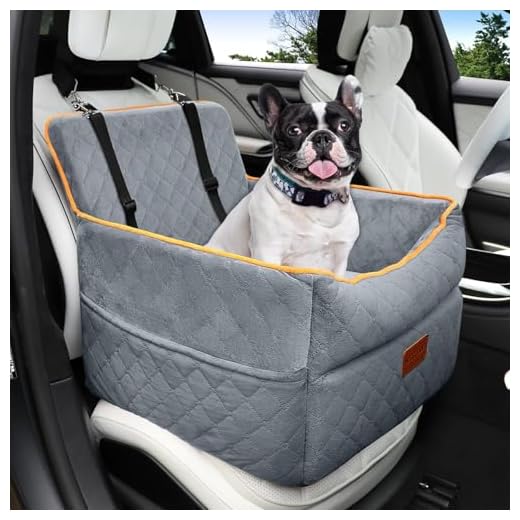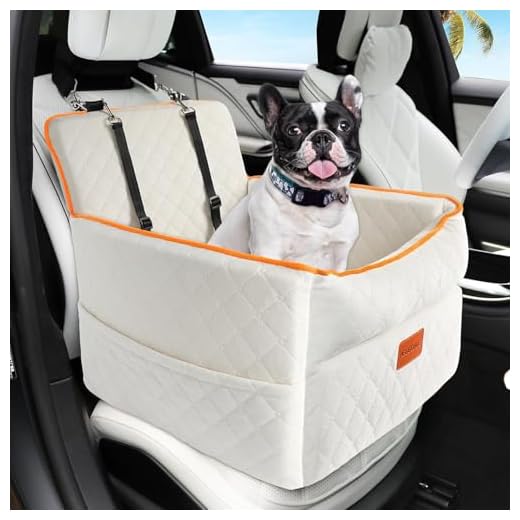




Using a restraint designed for car travel is a wise choice for anyone who cares about the safety of their furry friend. Quality restraints can significantly reduce the risk of injury during sudden stops or accidents, keeping your pet secure and preventing distractions while driving. When paired with a sturdy harness that fits well, these restraints can offer a reliable solution for pet owners.
Research indicates that unrestrained pets in vehicles can become projectiles during collisions, leading to severe injuries for both the animals and human occupants. Studies show that a correctly installed restraint can reduce these risks dramatically. Always ensure that the harness is properly fitted and the attachment point is secure to maximise protection. I once witnessed a near miss when my dog was loose in the backseat; it was a stark reminder of how quickly things can go wrong.
It’s essential to select a restraint that meets safety standards. Look for products that have been crash-tested and come from reputable manufacturers. I’ve tried a few options myself, and I can tell you that some may look appealing but lack the necessary safety features. Investing in a well-reviewed product not only guarantees a secure ride for your pet but also provides peace of mind for you as a driver.
Before hitting the road, take a moment to acclimate your dog to the restraint. Gradually introduce it during short trips, allowing your pet to become accustomed to the feeling. This practice can make a world of difference, transforming car rides from a source of anxiety to a fun adventure. Trust me, a happy, calm pet makes for a safer journey.
Safety of Harnesses Attached to Headrests
Using harnesses connected to the car’s headrest can be a mixed bag. While they might seem convenient, they often don’t provide adequate protection during sudden stops or accidents. I learned this the hard way when I noticed my furry friend sliding around the backseat during sharp turns. It quickly became evident that a more secure option was necessary.
One major concern is the lack of stability these devices offer. Unlike traditional harnesses that anchor to the seatbelt system, those attached to headrests can lead to excessive movement. This not only compromises your pet’s safety but can also distract the driver, increasing the risk of accidents. I witnessed a close call when a friend’s pooch, secured this way, ended up almost tumbling off the seat during a quick stop.
Another factor is the construction of the harness itself. Many of these models are not crash-tested, meaning they might fail to protect your pet in an emergency. I’ve invested in high-quality gear for my dog, focusing on products with safety certifications. It’s worth taking the time to research and choose options that prioritise your pet’s wellbeing.
In addition, consider the comfort aspect. Harnesses that are poorly designed can cause discomfort or even injury. I recall a time when I had to replace a harness because it chafed my dog’s skin. Ensuring that the gear fits properly and is made from soft materials can greatly enhance your pet’s experience during car rides.
Ultimately, opting for a harness that attaches to the seatbelt system directly is a wiser choice. These options provide better stability and protection, giving both you and your canine companion peace of mind. Safety should always come first, and choosing the right gear is a step in the right direction.
Understanding the Design of Headrest Dog Seat Belts
Choosing a restraint for your furry companion during car rides requires attention to detail. The construction of these restraints typically involves a durable strap that attaches to a vehicle’s headrest, ensuring stability while providing comfort to your pet. The adjustable nature of these straps accommodates various sizes, allowing for a snug fit without causing discomfort.
When I first purchased one of these restraints, I was impressed by how it featured a quick-release mechanism. This design allows for easy removal when you reach your destination, making transitions smooth. Additionally, the materials used are often weather-resistant, which is beneficial if your pet tends to get a bit messy after outdoor adventures.
Key Features to Consider
Look for designs that incorporate padded straps. This feature reduces friction and prevents chafing on your pet’s skin, enhancing overall comfort during long journeys. Some models even offer reflective stitching for added visibility at night, which is something I found particularly useful during evening drives.
Another aspect to consider is the attachment method. Many restraints come with a universal fit clip that secures easily to most headrests, ensuring a tight connection that won’t loosen during travel. Ensuring that the connection point is robust is crucial; I once had a less sturdy model, and it didn’t inspire confidence. A well-engineered attachment gives peace of mind and enhances safety.
Material Quality and Durability
Investing in high-quality materials is essential. Reinforced nylon and heavy-duty stitching are common in reliable models, providing strength and longevity. I noticed that the more robust restraints handled wear and tear much better than cheaper alternatives. This durability becomes apparent after multiple uses, especially in varying weather conditions.
Lastly, check customer reviews and feedback before making a purchase. Real-life experiences can reveal insights about performance and longevity that specifications alone might not convey. By selecting a restraint with thoughtful design and quality materials, you can enjoy worry-free travels with your beloved companion.
Evaluating Crash Test Results for Canine Safety
Rigorous crash tests reveal significant insights into the reliability of various restraints for pets during vehicle travel. It’s crucial to focus on products that have undergone standardised testing procedures, ensuring they meet safety benchmarks. For instance, products evaluated under the ASTM F2640-18 standard provide a reliable reference point for assessing protection levels.
Key Findings from Crash Tests
Recent studies indicate that harnesses that distribute force across a dog’s body outperform those that concentrate stress on a single point. During simulated collisions, well-designed harnesses showed a dramatic reduction in force experienced by canines, which is vital in minimising injury risk. Look for results that demonstrate a reduction of impact forces by at least 70% for optimal safety.
Recommendations for Pet Owners
Always opt for safety gear that has been crash-tested by reputable organisations. Pay attention to brands that publish their test results openly. If a product lacks transparent data, consider it a red flag. Additionally, evaluate the fit of the restraint–an ill-fitting harness can compromise safety during an accident. Regularly check for wear and tear, as materials can degrade over time, diminishing their protective qualities.
Comparing Headrest Restraints to Traditional Canine Harnesses
In my experience, using traditional harnesses for my pet has always felt more secure and reliable than newer alternatives. These harnesses distribute force across the body, reducing the risk of injury during sudden stops or collisions. They are designed to keep your furry friend snugly held in place without putting undue stress on their neck.
Comfort and Fit
One clear advantage of conventional harnesses is their ability to provide a custom fit. With various styles and sizes available, you can find one that suits your breed and size perfectly. Many models come with adjustable straps to ensure maximum comfort. I remember the first time I fitted my dog with a well-made harness; the difference in her comfort level was immediately noticeable. She could move freely without feeling constricted.
Ease of Use
Traditional harnesses often feature simple designs that make them easy to put on and take off. I prefer the quick-clip models that allow me to secure my pet in seconds. In contrast, some newer restraint systems may require more effort to install and adjust correctly. This could lead to frustration, especially if you’re in a hurry or your pup is particularly restless.
While newer restraint systems may claim to offer innovative solutions, the tried-and-true harness remains a solid choice for ensuring your pet’s safety and comfort while travelling. Always prioritise your pet’s well-being and choose the option that best meets their needs.
Identifying Compatibility with Different Car Models
Before purchasing a restraint system for your furry friend, check its compatibility with your vehicle. Not all designs fit every car, and ensuring a proper fit can enhance safety and comfort.
Key Compatibility Factors
- Headrest Design: Different vehicles come with varying headrest shapes and sizes. Measure the headrest’s width and height to ensure the restraint can anchor securely.
- Seat Type: Consider whether your car has bucket seats, bench seats, or a fold-down rear seat. Each type may require a different approach for securing the harness.
- Material Quality: Verify that the components are robust enough to withstand wear and tear. Look for high-quality materials that can endure regular use without fraying.
- Weight and Size Recommendations: Always adhere to manufacturer guidelines regarding your pet’s weight and size to ensure the chosen product is suitable.
Testing for Fit
- Install the restraint system according to the manufacturer’s instructions.
- Check for any slack in the harness once your pet is secured. A snug fit is crucial for safety.
- Take short trips to observe how your pet adjusts to the new setup. Look for signs of discomfort or stress.
- If possible, consult your vehicle’s manual for any specific recommendations regarding pet restraints.
By ensuring compatibility between the restraint system and your vehicle, you can provide a safer travel experience for your beloved companion. It’s worth the effort to get it right, as a secure fit reduces the risk of injury during sudden stops or accidents.
Tips for Proper Installation and Usage
Ensure that your canine companion is secured correctly by following these specific steps. First, read the manufacturer’s instructions carefully; they provide vital information for correct assembly and adjustments.
Next, attach the harness to your pet before securing it in the vehicle. This approach reduces stress for your furry friend by creating a familiar routine. Make certain that the harness fits snugly but is not too tight; you should be able to fit two fingers between the harness and your pet’s body.
Position the fastening mechanism so that it aligns with the vehicle’s headrest. This alignment helps distribute the force during sudden stops or impacts, offering additional support. Regularly check the connections to ensure they are not loose or damaged.
Consider the seating arrangement. Allocating a spot in the backseat can enhance comfort and reduce distractions while driving. Avoid placing the harness near airbags, as this can pose a risk during deployment.
Regularly assess your companion’s behaviour while secured. If they seem uncomfortable or anxious, it might be time to adjust the harness or consider a different style. Always monitor them during travel to ensure they are calm and relaxed.
| Tip | Description |
|---|---|
| Read Instructions | Familiarise yourself with the product guidelines for optimal use. |
| Fit Check | Ensure the harness fits well; not too loose or too tight. |
| Secure Connections | Regularly inspect all connections for wear or looseness. |
| Backseat Placement | Utilise the backseat for added comfort and reduced distractions. |
| Behaviour Monitoring | Watch your pet’s reactions to ensure they feel at ease. |
For those curious about canine behaviour, check out this article on why does my dog take his food out the bowl. Understanding their actions can help improve overall travel experiences.









